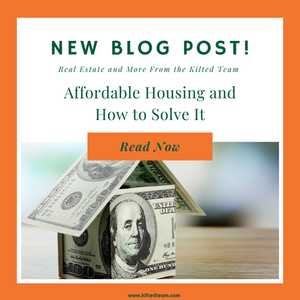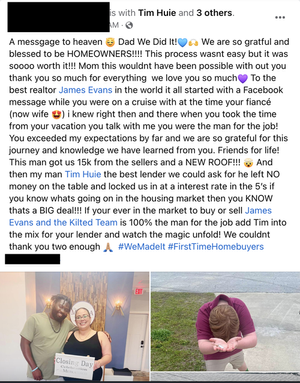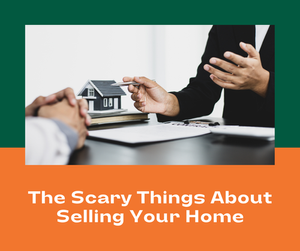I got an email from Florida Realtors this morning that told me something I’ve been telling clients for a long while — If you’ve purchased a home with me anytime in the last 7 years, you’ve heard me talk about prices and why they AREN’T going down anytime soon. Honestly, with the Federal Reserve talking about decreasing rates this year, it’s more likely prices continue to increase as the cost to finance reduces. But, pricing is a lot more nuanced than just interest rates. This article will go into
Why home prices are what they are
The future of real estate prices
Ideas that this real estate expert thinks can help more Americans purchase homes
Stick around! Number three is probably gonna get me in trouble. Let’s begin!
Real Estate Prices in 2024 - How Did We Get Here
That Florida Realtors article that set this blog in motion? It was titled “More Baby Boomers Opting to Age in Place”. I’ve been saying this since I started real estate! I am a Central Florida native - and I chose to stick around - but one thing I noticed was that my friend’s were moving away, but their parents. . . well their parents were staying put. When I got into this business, all of the gurus said “real estate is an 8 year game. The average homeowner stays for 7-8 years before you can sell their house again”. But, I was looking around at my friend’s lives and seeing the exact opposite! Their parents had bought their home in 2005-2012. But, I had gone through Seminole County Public Schools, UCF, and even started a career with the sheriff’s office, and these people hadn’t moved once. The ‘8 year average’ didn’t seem to be the new normal - even if the data still backed that idea up historically. Right now, 28% of all three bedroom homes in America are owned by older empty nesters - and over half of those polled reported having no interest in moving any time soon because of interest rates, paid off mortgages, or the cost to purchase another home! And, I’m not here to blame them. But, you do have to be realistic about what that means, 28% of single family homes will only trickle onto the market for the next 20 years as those opting to age in place begin to.. well.. stop aging and move on.
But, that’s only ONE economic datapoint. We also have to take the Great Recession into account. Specifically, how the Great Recession affected housing starts. Historic data says to keep up with depreciation and annualized per capita growth, we should have approximately 1M new construction starts per year. The market topped out in 2005 at 1.7M starts, but bottomed out in 2009 at just above 400k starts. From 2009 to 2020, 11 years, our country didn’t produce enough residential units to keep up with the growing demand. This means the overall supply of homes is crucially low. Coupled with increasing resentment of multi family housing plaguing zoning laws, and you’re looking at a huge reason why real estate prices have risen so rapidly.
Housing starts in America - Notice how long we were below 1 Million homes a year!
Finally, we have institutional investors. They’ve changed the game and the landscape. An institutional investor is any fund that has over 1,000 doors to their portfolio; and with the national median price over $400k, you’re talking a small handful of companies. And, they only make up 4% of national sales. But their influence can’t be understated.
Primarily because they aren’t buying across the nation.
Dallas, Texas for instance, 28% of the homes bought in 2021 were made by institutional investors. These metros saw above-average price appreciation in homes, even while income rose moderately or even stayed flat. Those same metros also saw their rents increase faster than the rest of the nation AND, more telling, cities which were targeted for these institutionals saw rents climb faster than cities that weren’t targeted - on a local, even neighboring zip code level! This data comes from HUD. The other lingering, long-term problem with these types of investors is their sheer bulk. When you own 1,000 units in a state, it becomes extremely expensive transactionally to unload them. So, what do you do? You slice up the portfolios, and you sell them, hundreds of homes at a time, to other large investors. This saves time, opportunity for mistake, and cost — but it also means ever address that goes to one of these investors is forever offline to the owner-occupant market; it’s now a rental, forever.
The largest price drivers for real estate have been a changing demographic with people aging in place; new construction lagging over a decade due to the Great Recession; and institutional investors who have driven pricing up and transitioned once purchasable real estate into offline rental homes!
Where Are Prices Heading?
There are many sayings that relate to this — “The best time to buy real estate was yesterday. The next best day, is today” or “You should buy real estate and wait, not wait to buy real estate”. Land is a finite resource. Every year our country exists, development happens, and land becomes more and more valuable. Prices will historically always go up and real estate has been a consistent hedge for inflation to combat that.
But, we listed three drivers for pricing. At least one of those drivers will begin to relax — that is, new construction starts are over 1M nationally. AND we’re seeing more and more cities relax their planning and zoning laws when it comes to new construction. Both of these things will start to ease the pressure on upward pricing. And we’re seeing that. Most experts have flat growth, between 3-6%, appreciation this year. I’m in that group too (I do disagree that rates will drop below 6%, I personally see them staying in the 6’s all year, with drops starting in June and leading up to the election).
The average length of owning a particular home going up though likely isn’t coming down soon. People will always sell for life changes - death, divorce, babies being born, job relocations - these things aren’t going away. But, overall, this trend of aging in place will continue to go up, and this will continue to be a pressure on the housing supply.
Institutional investors are really the mixed bag here. All indicators say they’re here to stay! One of the ongoing trends recently is build-to-rent communities. Neighborhoods built by national and even local builders and buying sold as a package deal to an institutional investor for the sole purpose of renting it out. We have one in Maitland actually called The Reserve at Hillview. Rents starting at $3120 for a 4 bedroom home. More troubling is these are expected to grow in popularity with these institutional investors - 34% of homebuilders have sold stock to institutional rental operators as part of funding. Meaning these rent-to-build communities will likely continue to soar as they now are helping drive the car of where and how homes will be built. The reason it’s a mixed bag here is that both local, state, and some federal initiatives have already started looking at the effect these investors are having on the real estate markets across America. It’s possible legislation is drafted and enacted that curbs these investors.
On a personal side, I agree with these legislations within reason. I do see Wall St as a threat to home affordability in America in the long term.
Going forward, I believe the biggest risk to price increases outside of the norm would be for interest rates to drop below 6%. I’m willing to forecast this out for the next 18 months honestly.
Buying A Home - Is It Possible? Is It Worth It?
It’s definitely possible to buy a home. Heck, this year I wrote a story about my first closing of 2024 - a first time homebuyer who got $15,000 in cash and a new roof in concessions. So yeah, we’re making dreams come true at The Kilted Team! Plus, Hometown Heroes is currently scheduled to come back this year as well - a phenomenal resource for down payment assistance and one my lender and I closed successfully multiple times in 2023. Buying a home is not only possible, but it’s still worth it. Remember, homeowners have a net worth 40x higher than renters. End of the day, you need shelter. So it may as well pay you back while you pay for it!
And for current homeowners, does it make sense for you to move? Well, honestly that question is more nuanced. There are common paint points and fears of sellers, but every situation is different. If you want an objective, expert opinion, I always have 15 minutes to be nice. So let’s schedule a call.
But many sellers are feeling handcuffed to their low interest rates. And that’s a VERY real concern as to whether or not it’s worth it to give that rate up because they aren’t ever coming back. Those 2-4% rates were caused by quantitative easing to help ease the burden of the Great Recession; meaning, they weren’t real. Historically, 7% isn’t a bad rate for mortgages when you look at the history of America. But it’s a terrible rate if you’ve been interested in real estate anytime in the last 15 years - which is where most current owners are sitting.
What Can We Do To Change The Future?
Affordable housing is a major concern for everyone. You’re hearing our President talk about it, both parties, your barber, and everyone else you know. In Florida, the median household income is $54,000. And Central Florida median price was $377k - an almost 7x multiple! I’m helping people buy and sell homes, but at some point, we reach a critical breaking point and home ownership becomes a dream for many instead of a reality. We have to look at the longer term bigger picture - if income and prices increase in Florida at the current rate, we will see homeownership decline as first time home buyers are priced further outside the realm of buying. Check the chart below! Median household income in 1984 was $19,790. In 2022, it was $65,370. A total 230% increase or 6% yearly. The median sales price of a home in 1984 was $78,200 and in 2022, it was $417,700. A 434% increase, or 11% a year. Home prices are outpacing income nearly 2:1 in Florida!
Median HOUSEHOLD income 1984-2022
Median sales price 1984-2022
First and foremost, I think we should ban, on a federal level, built-to-rent single family communities. Land is finite. And by building these communities we’re utilizing valuable land, zoned for single family owner occupants, and taking them completely out of the equation in perpetuity. These build-to-rent communities are effectively commercial factories for rental providers. Except, they’re bought at discount by huge investors, and managed for the sole profit of a single company. Even having build-to-rent communities owned by 150 different small landlords who own a house or two would be preferable to large institutional investors because at least the money stays in the local economy. Blackstone Group, the largest investor in the nation, averages profits over $1Bn a year. Money that benefits no one except Blackstone. I don’t typically have an issue with businesses making money, but when it prices Americans out of homes, I have a sincere problem with that.
We also need local governments to take a closer look at planning and zoning. Florida law preempts cities from being able to say “NO!” to development, but it doesn’t strip cities of their ability to tailor development to specific needs. I actually made this a platform piece when I ran for city commission in Winter Springs. Using local codes and ordinances to encourage certain types of development to what’s both needed and wanted. Allowing more medium density infill (townhomes) in downtown areas allows for more homes without taking away from local charms. Mixed use zoning that interweaves commercial and residential, is also a smart step in the right direction!
We also need to stop looking down on high density units! Whether they be condos or apartment buildings. Housing is at a premium and they serve crucial roles in the community. I routinely hear that apartment buildings bring transients, crime, and low income. But when it costs $2000 for a 2 bedroom apartment, you’re talking about household incomes higher than $75k! If you’re curious, that means your local teachers, firefighters, and police officers can’t afford to live in the cities they serve without a roommate.
The last two items must be done with a look at aesthetics in local planning as well. Development requiring cohesiveness with the surrounding areas, multiple textures on the facade, increased requirements for vegetation and foliage, all of these things can be used to minimize the visual impact of large residentials (and commercial) projects. And bringing mixed use components makes both business and people happier as they both are closer and more walkable to each other.
Finally, we need to make the down payment programs more uniform. Florida has Live Local, Hometown Heroes, HFA Preferred, SHIP, and a whole host of others. I’m a seasoned veteran, and I’ll be honest, I don’t understand why we have so many different programs. Personally, I’d like to see our state reduce the number of programs to make them more streamlined and just fund those programs with the rollover from programs we cut. Maybe we have a bond program, grant program, and a “specialty” program (like Hometown Heroes). But having more programs benefits less people. And if you want another datapoint to prove my point, the 2022 Annual Report from Florida Housing Finance Corp (the agency who doles the money out) did 5,502 loans using assistance. 5078 of those loans came through TWO types of programs - Florida Assist ($10,000 bond), and Hometown Heroes.
Conclusion
Homeowners have net worths 40x higher than renters. That statistic has been historically accurate since it’s been tracked! Homeownership makes people wealthier. Period. And it should be something we encourage as an economy. Buying a home is still a very real possibility for Americans and Floridians, but I it is being threatened. But I believe there are common sense solutions available to help Floridians feel relief while purchasing AND by seeing our communities thrive with more walkability, and more planning when it comes to where we put density and why we put it there.
But, until then, if you need to buy a home call the Kilted Team! You can start your home search here. I have a background in finance and economics, I’ve written over 100,000 words on personal finance, and I’m an expert when it comes to negotiating concessions for my clients and an expert on down payment programs in Florida.
And if you need to sell a home, I can help you too. Start your journey by checking out my listing portfolio here. I sell for 99% of list price and 3x faster than other Central Florida agents if you check the data. But, I believe it’s my white-glove service, meticulous care for your family’s needs, and having a consistent track record of doing all of that.
I’m hopeful Florida will move forward on keeping home ownership accessible for us all! Housing is a need, but affordable housing is a must. It benefits our schools, local businesses, and communities to reduce the cost of shelter in Florida and keep money flowing in our local economies.
Join The Kilted Community!
Did you like this article? I’ve got a lot more original content!
Join a thriving group of locals - we meet monthly to socialize, and we impact our community through donations and community work. Easy Living in Seminole County Facebook Group is a great place to meet locals in person and online and benefit the community at large by joining our group funding.
A monthly newsletter with real estate talking points, community events, and other original content that 1600 other locals enjoy each month! Fill the contact out and just say newsletter!
Follow me on Facebook! I post the best memes, reels, and hot takes in Central Florida.









